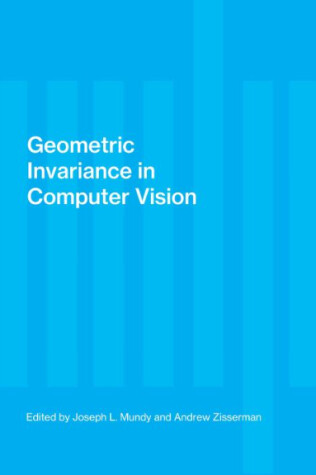Artificial Intelligence
2 total works
Geometric Invariance in Computer Vision
by Joseph L. Mundy and Andrew Zisserman
Published 27 May 1992
These twenty-three contributions focus on the most recent developments in the rapidly evolving field of geometric invariants and their application to computer vision. The introduction summarizes the basics of invariant theory, discusses how invariants are related to problems in computer vision, and looks at the future possibilities, particularly the notion that invariant analysis might provide a solution to the elusive problem of recognizing general curved 3D objects from an arbitrary viewpoint. The remaining chapters consist of original papers that present important developments as well as tutorial articles that provide useful background material. These chapters are grouped into categories covering algebraic invariants, nonalgebraic invariants, invariants of multiple views, and applications. An appendix provides an extensive introduction to projective geometry and its applications to basic problems in computer vision.
Visual Reconstruction presents a unified and highly original approach to the treatment of continuity in vision. It introduces, analyzes, and illustrates two new concepts. The first -- the weak continuity constraint -- is a concise, computational formalization of piecewise continuity. It is a mechanism for expressing the expectation that visual quantities such as intensity, surface color, and surface depth vary continuously almost everywhere, but with occasional abrupt changes. The second concept -- the graduated nonconvexity algorithm -- arises naturally from the first. It is an efficient, deterministic (nonrandom) algorithm for fitting piecewise continuous functions to visual data.The book first illustrates the breadth of application of reconstruction processes in vision with results that the authors' theory and program yield for a variety of problems. The mathematics of weak continuity and the graduated nonconvexity (GNC) algorithm are then developed carefully and progressively.Contents: Modeling Piecewise Continuity. Applications of Piecewise Continuous Reconstruction. Introducing Weak Continuity Constraints. Properties of the Weak String and Membrane.
Properties of Weak Rod and Plate. The Discrete Problem. The Graduated Nonconvexity (GNC) Algorithm. Appendixes: Energy Calculations for the String and Membrane. Noise Performance of the Weak Elastic String. Energy Calculations for the Rod and Plate. Establishing Convexity. Analysis of the GNC Algorithm.Visual Reconstruction is included in the Artificial Intelligence series, edited by Michael Brady and Patrick Winston.
Properties of Weak Rod and Plate. The Discrete Problem. The Graduated Nonconvexity (GNC) Algorithm. Appendixes: Energy Calculations for the String and Membrane. Noise Performance of the Weak Elastic String. Energy Calculations for the Rod and Plate. Establishing Convexity. Analysis of the GNC Algorithm.Visual Reconstruction is included in the Artificial Intelligence series, edited by Michael Brady and Patrick Winston.

